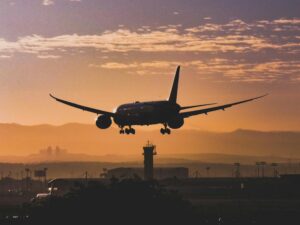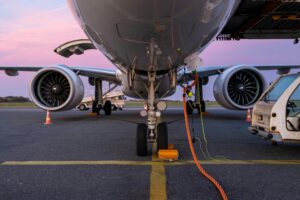Every year, the Harmattan season brings a predictable crisis to Nigerian aviation. As the dusty winds sweep across West Africa between November and March, visibility plummets. Flights get cancelled. Passengers become stranded. Airlines lose millions. But here’s the truth that few industry leaders acknowledge: these disruptions aren’t primarily weather problems – they’re policy failures.
The solution requires a systematic overhaul of Nigeria’s approach to low-visibility operations, addressing four critical areas that currently fall short of international standards.
The Four-Part Problem
Nigerian aviation faces weather-related disruptions because the entire ecosystem – from ground infrastructure to aircraft equipment to personnel training – lacks harmonized standards for operating in poor visibility conditions. While individual components of the system may meet certain requirements, the absence of a coordinated approach means the entire system fails when visibility decreases.
Sindy Foster, Principal Managing Partner at Avaero Capital Partners, identified this problem in August 2022, recommending a comprehensive audit of visual flight rules (VFR) and instrument landing systems (ILS) capabilities. Nearly two years later, these recommendations remain relevant as the industry has yet to implement the systematic changes needed.
The solution requires upgrading four interconnected elements to a minimum of Category II Instrument Landing System (CAT II ILS) standards:
Infrastructure Upgrade Requirements
First, the Nigerian Airspace Management Agency (NAMA) must ensure all major airports have functional CAT II ILS equipment – the navigation aid that guides aircraft to runways during low visibility. CAT II systems allow aircraft to land with visibility as low as 350 meters – sufficient for most Harmattan conditions.
However, ILS equipment alone solves only part of the problem. The Federal Airports Authority of Nigeria (FAAN) must complement these navigation aids with appropriate runway lighting systems certified to CAT II standards. Many Nigerian airports claim CAT II capability based solely on navigation equipment while lacking the corresponding runway lighting infrastructure.
A runway cannot truly be considered CAT II capable without both components working in tandem. Additionally, these systems require regular calibration – a maintenance step often overlooked in the current regulatory environment.
Aircraft and Personnel Readiness
Even with perfect ground infrastructure, operations during low visibility would still fail without properly equipped aircraft. Airlines operating in Nigeria must ensure their fleets have the necessary onboard systems compatible with CAT II approaches.
Beyond equipment, the human element proves equally critical. Pilots need specialized training to execute CAT II approaches safely. This training goes beyond basic instrument qualifications, requiring regular practice and proficiency checks specifically for low-visibility operations.
Currently, no comprehensive assessment exists showing which Nigerian airlines have both the aircraft capabilities and properly trained pilots to conduct CAT II operations. This information gap makes policy implementation impossible to track and enforce.
The Statutory Minima Problem
Perhaps the most counterproductive element of Nigeria’s current approach is the existence of statutory state minima – predetermined visibility requirements that exceed manufacturers’ recommendations and international standards.
These artificially high minima force flight cancellations even when aircraft, pilots, and infrastructure are technically capable of safe operations. The solution requires abolishing these one-size-fits-all limitations at airports with CAT I or CAT II ILS systems and replacing them with performance-based standards tied to actual aircraft and crew capabilities.
Aircraft manufacturers spend millions determining safe operating limitations for their aircraft. Airlines invest heavily in pilot training. When both meet international standards, arbitrarily elevated minima serve no safety purpose – they only create unnecessary disruptions.
Implementation Through Matrix Management
Implementing these changes requires a coordinated approach. Foster suggests creating a comprehensive matrix that would clearly identify:
1. Which airports have CAT II ILS equipment and corresponding runway lighting
2. Which airlines operate aircraft with CAT II approach capabilities
3. Which pilots have current training and certification for CAT II approaches
4. The current statutory minima versus manufacturer-recommended minima for each aircraft type
This matrix would reveal gaps between current capabilities and the needed standards, allowing regulators and industry stakeholders to prioritize investments and training programs. It would also provide transparency regarding which combinations of airports, aircraft, and crews can operate safely during reduced visibility.
The Economic Imperative
The economic cost of Harmattan-related disruptions extends far beyond airlines. Every cancelled flight represents lost productivity for business travelers, missed connections for international passengers, and delays in cargo delivery. These costs ultimately undermine Nigeria’s economic competitiveness and integration with global markets.
While upgrading infrastructure, aircraft, and training requires investment, the cumulative cost of recurring seasonal disruptions far exceeds these one-time expenditures. Moreover, the technology and expertise needed already exist – what’s missing is the regulatory framework to implement them systematically.
Moving Forward
Nigerian aviation authorities need to establish clear timelines for compliance with these minimum requirements. Such a timeline should include deadlines for:
– NAMA to install and calibrate CAT II ILS equipment at all international airports
– FAAN to upgrade runway lighting systems to CAT II standards
– Airlines to ensure aircraft meet CAT II approach requirements
– Pilots to complete CAT II approach training and certification
– Regulatory authorities to revise statutory minima to align with manufacturer specifications
Weather will always present challenges to aviation operations. However, Nigeria’s current level of disruption during Harmattan season represents not an inevitable natural phenomenon but a solvable regulatory and infrastructure problem.
By implementing these interconnected solutions, Nigerian aviation can dramatically reduce weather-related cancellations, improve safety through standardization, and provide the reliable air transport system essential for economic growth. The Harmattan doesn’t need to shut down Nigerian skies – only policy failures do that.
Disclaimer: The insights shared in this article are for information purposes only and do not constitute strategic advice. Aviation markets and circumstances vary, and decisions should be based on your organisation’s specific context. For tailored consultancy and guidance, please contact info@avaerocapital.com.




